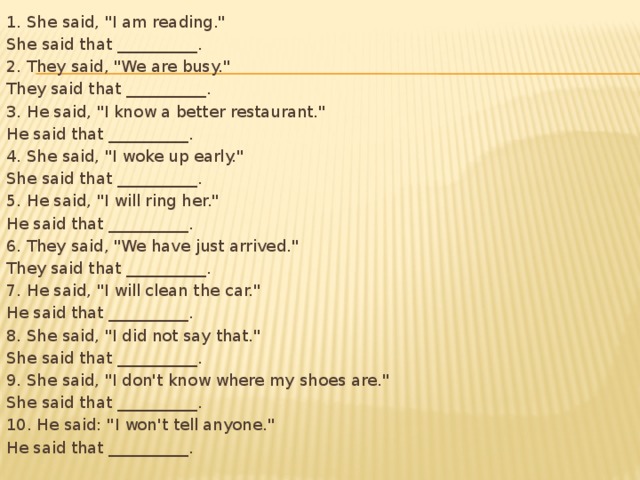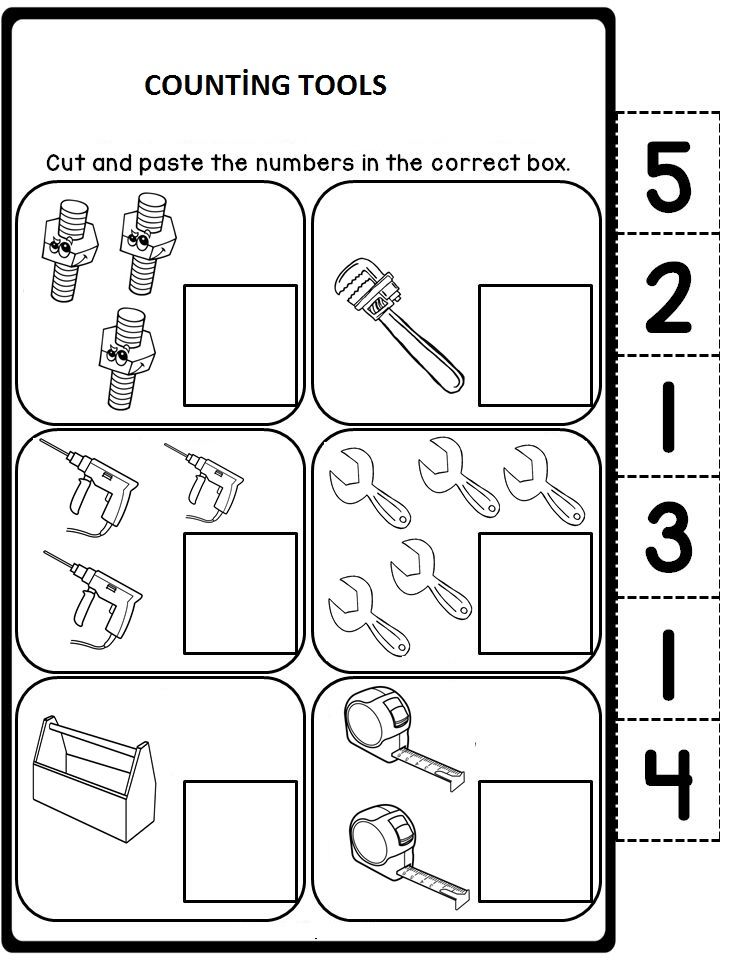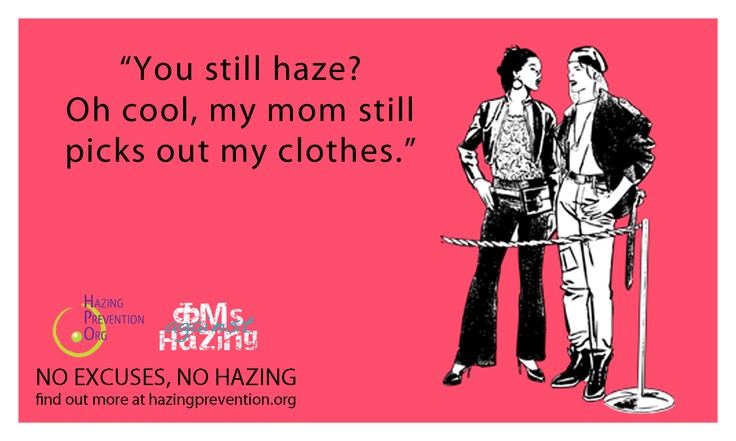How to handle an autistic tantrum
a guide for all audiences
Many autistic people have meltdowns. The public often finds it hard to tell autism meltdowns and temper tantrums apart, but they are very different things. If your family member or the person you support has meltdowns, find out how to anticipate them, identify their causes and minimise their frequency.
What is a meltdown?
A meltdown is an intense response to an overwhelming situation. It happens when someone becomes completely overwhelmed by their current situation and temporarily loses control of their behaviour. This loss of control can be expressed verbally (eg shouting, screaming, crying), physically (eg kicking, lashing out, biting) or in both ways.
A meltdown is not the same as a temper tantrum. It is not bad or naughty behaviour. When a person is completely overwhelmed, and their condition means it is difficult to express that in another way, it is understandable that the result is a meltdown.
Meltdowns are not the only way an autistic person may express feeling overwhelmed. They may also refuse to interact, withdrawing from situations they find challenging or avoiding them altogether.
What to do
If someone is having a meltdown, or not responding to you, don’t judge them. It can make a world of difference to an autistic person and their carers.
- Give them some time - it can take a while to recover from information or sensory overload.
- Calmly ask them (or their parent or friend) if they’re OK, but bear in mind they’ll need more time to respond than you might expect.

- Make space - try to create a quiet, safe space as best you can. Ask people to move along and not to stare, turn off loud music and turn down bright lights – whatever you can think of to reduce the information overload, try it.
Anticipating a meltdown
Many autistic people will show signs of distress before having a meltdown, which is sometimes referred to as the “rumble stage”. They may start to exhibit signs of anxiety such as pacing, seek reassurance through repetitive questioning or physical signs such as rocking or becoming very still. At this stage, there may still be a chance to prevent a meltdown. Strategies to consider include distraction, diversion, helping the person use calming strategies such as fiddle toys or listening to music, removing any potential triggers, and staying calm yourself.
Identifying the causes
A meltdown is a reaction to an overwhelming experience. If your family member or the person you support has meltdowns, identify what is overwhelming for them. Complete a diary over a period of time. Record what happened before, during and after each meltdown. Patterns may emerge. You may find that meltdowns occur at particular times, in particular places, or when something particular has happened.
Minimising triggers
Once you have a clearer idea what may be triggering meltdowns, think about ways you might minimise that trigger. Every autistic person is different, but sensory differences, changes in routine, anxiety, and communication difficulties are common triggers.
Sensory considerations
Many autistic people have sensory differences. They may be over-sensitive to some senses, under-sensitive to others and often a combination of both.
For example, for someone who is over-sensitive to touch and sound, people brushing past them and a loud announcement at a train station could cause pain and sensory overload, leading to a meltdown. In this situation, it could be helpful to listen to calming music on headphones to block out loud noises and to wait until everyone has got off the train before approaching the platform to avoid crowds of people.
In other situations, consider creating a low arousal environment (eg remove bright lights) or use sensory equipment (eg glasses with dark or coloured lenses, ear defenders, a weighted blanket).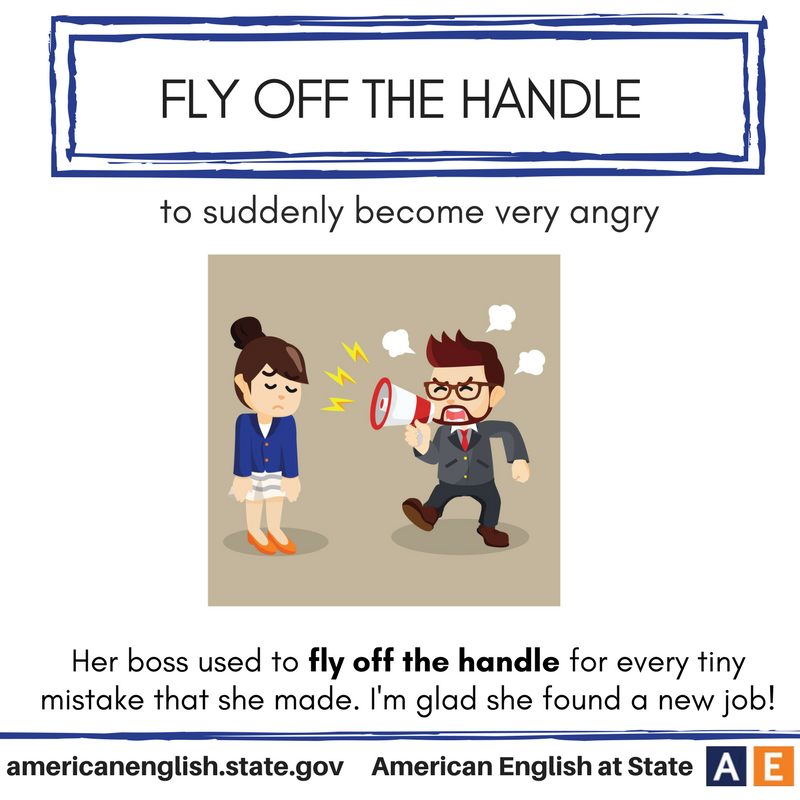
Change in routine
Consistent, predictable routines and structure are very important for autistic people and a change to routine can be very distressing.
For example, having to go a different route to school due to roadworks could cause feelings of anxiety, that may trigger a meltdown. In this example, a clear visual support explaining the change, reassurance that the rest of the routine remains the same and adding extra support such as a calming/comforting activity to do in the car could help.
For an unexpected change, there can be a particular plan in place, such as:
- the use of a picture symbol to explain the change
- reinforcement of the rest of the day being the same (if that’s the case)
- a chance to express any frustration appropriately (such as hitting a pillow, ripping paper) followed by an activity that is known to calm the person such as taking deep breaths, listening to calming music, going for a walk, or squeezing a stress ball.

It may help to increase structure around ordinary transitions, helping the person to navigate the change from one activity to another throughout the day. Using a clear timetable explaining when the transitions will be, using timers to count down to transitions, using a favourite toy or character to be part of the transition, can all help.
Anxiety
With its unwritten rules and unpredictable nature, the world can be an extremely challenging environment for autistic people and many experience anxiety. Without tools and strategies to help manage their feelings of anxiety, they may experience a meltdown.
Develop strategies to manage anxiety, such as the Brain in Hand digital self-management support system.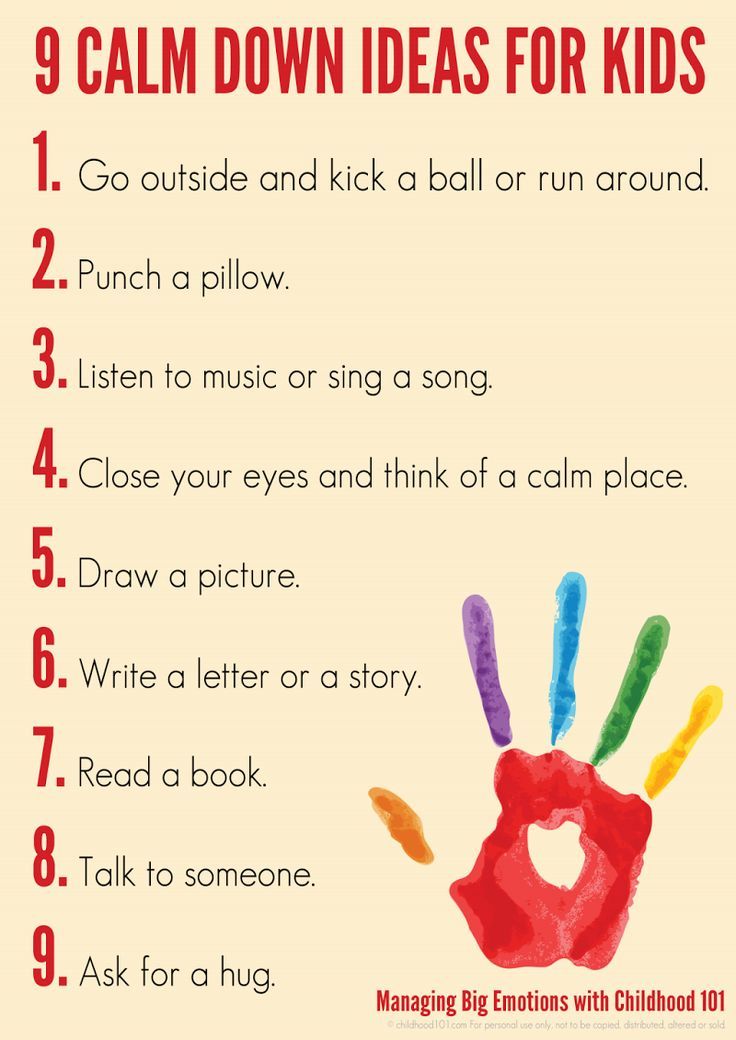
Have a plan beforehand of what to do if the person feels anxious, such as a calming playlist to listen to at the shops or a stress ball in their pocket.
Build relaxation time into the routine. The person will generally feel calmer and therefore better able to manage when something that could trigger a meltdown, occurs. What that means will vary from person to person, and may consist of quiet activities, eg taking a walk, listening to music, playing a computer game, reading, doing puzzles, using fiddle toys, or more strenuous activities, eg jumping on a trampoline or going to the gym.
In the case of more strenuous activities, observe whether the activity really does calm the person down. If it doesn’t, but is just an activity they really enjoy, still build in time for that activity but also try and find one that does genuinely calm them down and make time for that as well.
Communication difficulties
Autistic people can find it difficult to express their wants and needs, from a non-verbal child struggling to express their need for a drink to a teenager finding it hard to express their emotions. This can result in overwhelming feelings, such as anger and frustration, leading to a meltdown.
Support the person to find ways to understand and express their emotions appropriately before they get overwhelmed, and find ways to make your own communication more easily understandable. Some autistic people may find verbal communication difficult due to misunderstanding body language, tone of voice, irony and sarcasm.
Things you can try include:
- visual supports
- social stories
- Picture Exchange Communication Systems (PECS)
- written information
- modifying your verbal communication eg by speaking in short, clear sentences
- using technology such as tablets and voice software, instant messaging etc
- increasing understanding of emotions and social skills.
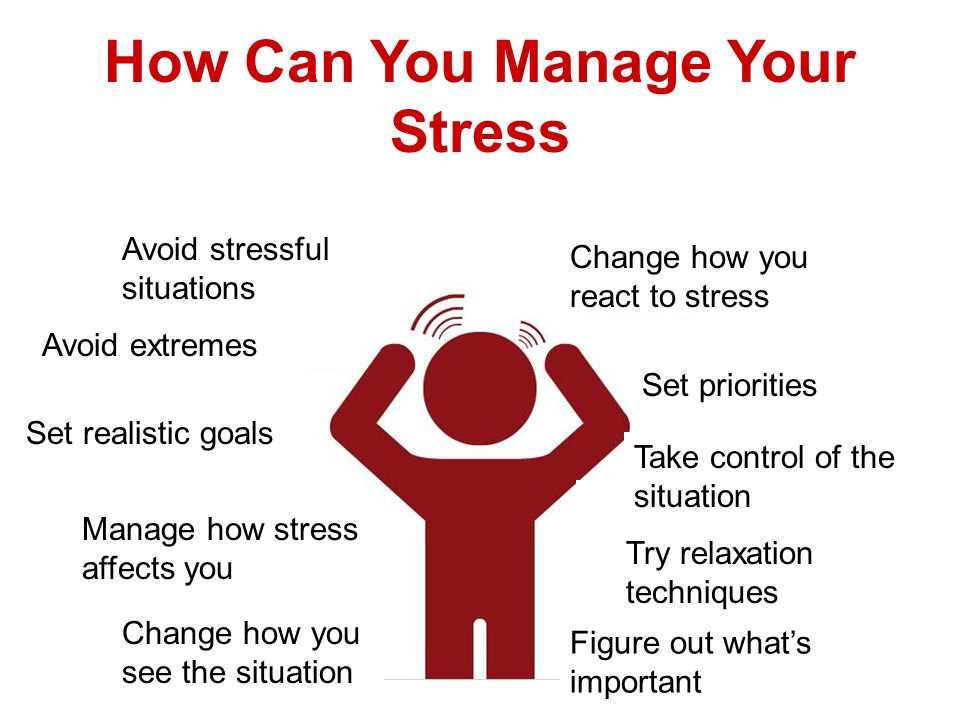
More from our charity
- Communicating and interacting
- Anxiety
The Best Strategies for Calming Autism Meltdowns and Tantrums
Updated by Shea Brogren, MOT, OTR/L
If you’re a parent of a neurotypical child, you’ve surely experienced the temper tantrums that come along with denying your child that candy bar in the grocery aisle, or (gasp!) making them wear the Sesame Street t-shirt instead of the preferred dinosaur t-shirt!
If you’re a parent of a child with autism, it’s less likely that you can predict what will cause behavioral and emotional meltdowns from day to day, situation to situation, environment to environment.
In this article, we will show you how to recognize the differences between how these behaviors are characterized: autism tantrums versus autism meltdowns.
They are not the same and cannot be addressed in the same way. After discussing each one, we will look at how to best calm down a child with autism depending on if they are having a tantrum or a meltdown.
- A Temper Tantrum is Not an Autism Meltdown
- Autism Meltdowns Come from Overwhelm or Overstimulation
- What to do When an Autistic Child has a Tantrum
- Recognizing the motivation or purpose of the tantrum
- Reinforcing positive behavior
- Building the skills
- Autism Meltdown Strategies for Children
- Portable Sensory Toolkit for Meltdowns
- Tantrums, Meltdowns, and Takeaways
A Temper Tantrum is Not an Autism Meltdown
A temper tantrum usually occurs when a child is denied what they want to have or what they want to do.
Parents observe many tantrums during the “terrible twos”.
In fact, this “terrible twos” stage is typically experienced between 12 months through 4 years old!
When you look at why temper tantrums occur at this stage, it is important to consider typical development and why toddlers are so easily frustrated:
- Emerging desire to become independent, but limited motor skills and cognitive skills (planning, organization, execution) make it impossible to actually BE independent.
- Emerging, developing language skills make communicating wants/needs frustrating.
- The prefrontal cortex of the brain has not yet developed - this is the brain center responsible for emotional regulation and social behavior - so they do not have the ability to regulate!
- Toddlers are developing an understanding of their world, and it’s often anxiety-producing. This anxiety and lack of control often result in tantrums when it all gets to be too much to manage.
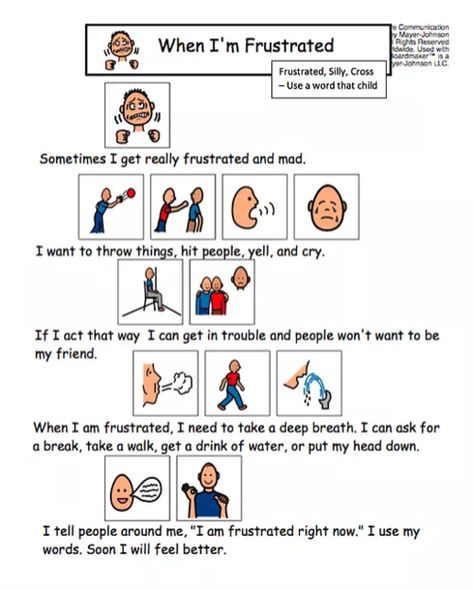
A hallmark of a tantrum is that the behavior will usually persist if the child gains attention for his behavior, but will subside when ignored.
When children tantrum, they continue to be in control of their behavior and can adjust the level of the tantrum based on the feedback they receive from adults around them. The tantrums will resolve when the child either gets what he wants or when he realizes that his outburst will not result in getting his way.
When parents “give in” to tantrum outbursts, children are more likely to repeat the behavior the next time they are denied what they want or need.
Children who exhibit frequent tantrum outbursts have difficulty regulating emotions associated with anxiety and anger. They can be impulsive in their reactions and, if not addressed appropriately, persistent outbursts (maladaptive responses to problems/not getting his way) can result in social-emotional difficulties as they get older.
While a tantrum isn't a meltdown, they are related and can be difficult to decipher, especially if you aren't the direct caregiver to the child.
Next, let’s answer the question. What is an autism meltdown? A meltdown is when the child loses control over his behavior and can only be calmed down by a parent, or when he reaches the point of exhaustion. These will sometimes be referred to as autism outbursts, but we will refer to it solely as an autism meltdown in this article.
Meltdowns are reactions to feeling overwhelmed and are often seen as a result of sensory overstimulation (check out our YouTube video below). Tantrums can lead to meltdowns, so it can be hard to tell the difference between the two outbursts (and respond appropriately) if you’re not attuned to your child’s sensory signals.
For more information on sensory processing, check out Harkla’s article here.
When a person with autism experiences too much sensory stimulation, their central nervous system is overwhelmed and unable to process all of the input. It’s a physiological "traffic jam" in your central nervous system and the sensory overstimulation is not unlike a maladaptive response to an actual traffic jam.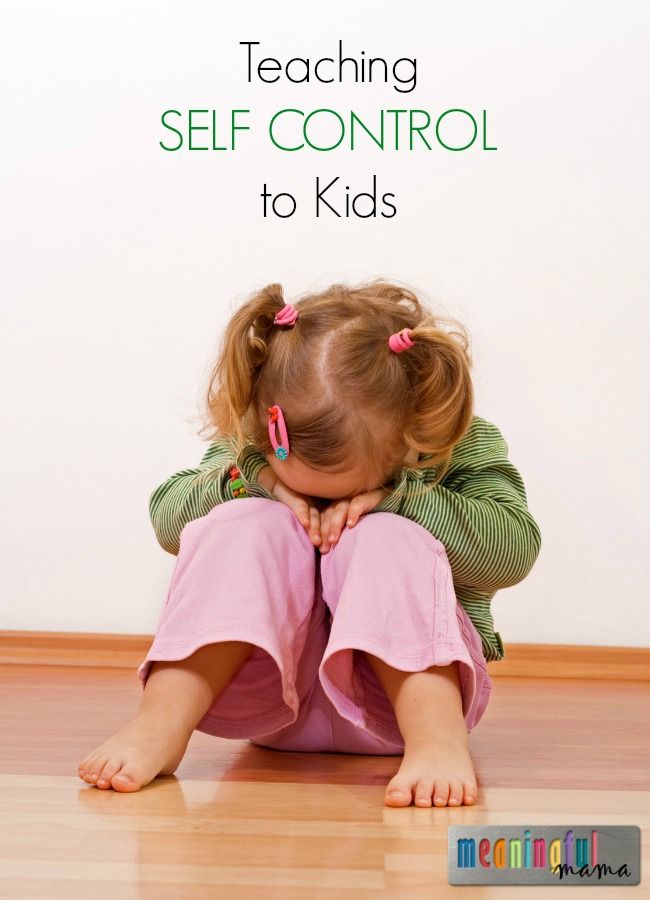
We’ve all had the experience of happily driving to our destination, cruising down the highway singing along to our favorite song, when all of a sudden traffic comes to a dead stop. Now, instead of comfortably cruising (our expectation for the situation), you’re at a standstill surrounded by imposing big trucks, offensive exhaust fumes, blaring horns, and the blazing hot sun peeking through your windows.
The anxiety of the situation is compounded by the sensations you’re experiencing and, all of a sudden, the music in your own car is too much to bear (sensory overload).
The last thing you want is to be stuck in your car in that traffic jam - you want out!
But you can’t go anywhere… the typical response at this point is agitation and frustration. Maybe you shut off the radio, close your eyes, and take some deep breaths to calm down (adaptive response). OR maybe you just can’t handle it and have a road rage outburst (maladaptive response)!
In times of anxiety and stress, the sympathetic part of your Autonomic Nervous System produces cortisol hormones and triggers a “fight or flight response. ”
”
When people with autism or sensory processing dysfunction experience sensory overstimulation, they are unable to regulate the sensory inputs from their environment and their bodies perceive these inputs as threats.
While the road rage analogy may seem extreme, it is important to view these sensory meltdowns as physiological responses and not controllable behavioral reactions. You cannot expect logical, rational responses to sensory situations when your body is perceiving those situations as threatening.
The bottom line is that tantrums are behavioral, learned reactions to certain situations. If the tantrums become severe enough, behavior plans may need to be put in place in an effort to decrease the unwanted behaviors. On the other hand, autism meltdowns are the body’s response to sensory stimuli, when these stimuli are perceived as threatening or overwhelming. Keeping this in mind, the strategies for managing meltdowns are much different than those of managing temper tantrums.
Now that you understand the fundamental differences between temper tantrums and meltdowns, you’ll recognize that the strategies to address tantrums are rooted more in behavioral supports and skill-building.
There are a number of parent-friendly resources that target tantrum management strategies and the majority of them focus on a three-fold approach/
1) Recognizing the motivation or purpose of the tantrum behaviorHere are a few examples of motivation children might have:
- to get attention
- to get what he wants/needs
- denial of want/need
- delayed access to what he wants/needs
Once you identify WHY your child is tantruming, you can respond more appropriately.
Recognize your child’s needs in the moment, without giving into them.
For example: Bobby wanted to choose the TV show but his sister put on Sesame Street before he got to the remote to turn on Dora.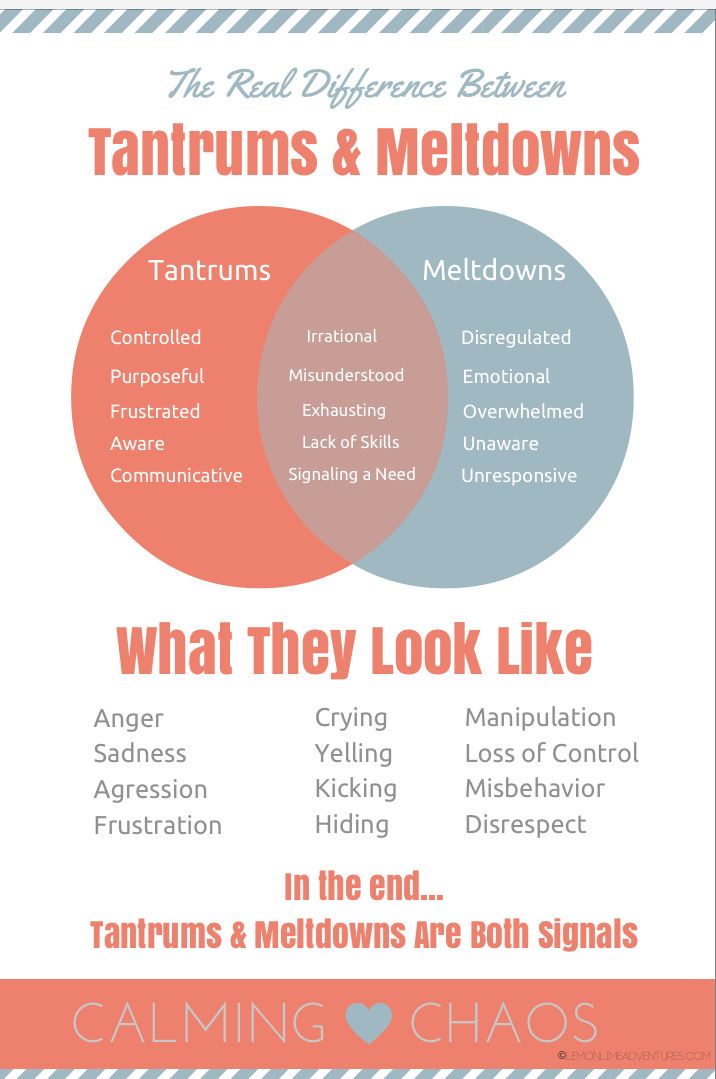 Bobby is now on the floor kicking, yelling, and crying (tantrum). Bobby wanted to choose Dora as the TV show but didn’t get his way (purpose of behavior). The adult could calmly, concisely respond with “I see that you are [angry/disappointed/frustrated] because you didn’t get to choose your TV show. When you’re calm, we’ll talk about it (walk away)” (parental response).
Bobby is now on the floor kicking, yelling, and crying (tantrum). Bobby wanted to choose Dora as the TV show but didn’t get his way (purpose of behavior). The adult could calmly, concisely respond with “I see that you are [angry/disappointed/frustrated] because you didn’t get to choose your TV show. When you’re calm, we’ll talk about it (walk away)” (parental response).
When Bobby calms down, he can then be engaged in conversation about how to solve the TV show problem but he does not get his Dora TV show immediately.
2) Reinforce positive behaviorCatch your child when they ARE responding appropriately to small problems and praise them or reward them for great behavior! A hug, high-five, or “Way to go!” are all ways of proactively avoiding those tantrum outbursts by teaching your child that he has your attention for the times he’s successful too!
Calling attention to what he does right, in the moment, will also help him build on those successes and positively respond in the future! In addition, modeling appropriate behavior yourself or pointing out acceptable behaviors in others can help reinforce appropriate ways for your child to respond and behave.
We know that children who demonstrate temper tantrums frequently struggle with impulse control, problem-solving, delaying gratification, negotiating, communicating wishes and needs, knowing what’s appropriate in given situations, and self-soothing.
Look for opportunities to build on these skills with your child and help them to be successful. It is best to work on these skills outside of tantrum moments, however.
You’ve heard the saying: “When you’ve met a child with autism, you’ve met one child with autism.”
Because every autistic child presents differently, with varied skills, levels of relatedness, communication, and sensory processing profiles, it is impossible to have a one-solution-fits-all approach to managing meltdowns.
The following are some tips and strategies that have helped other parents, but you will have to consider these in terms of your individual child’s needs.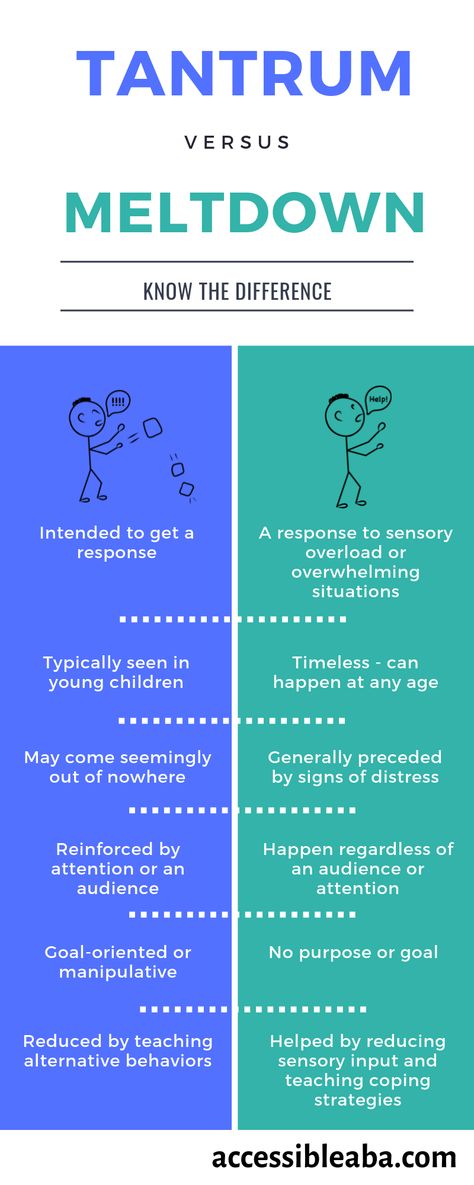
We’d all like to avoid meltdowns completely, but that’s not possible. Instead, some parents find it helpful to put strategies in place to minimize the stress and anxiety of daily life that may contribute to a meltdown. This is typically referred to as a sensory diet and can be beneficial in preventing and managing autism meltdowns.
Some common ones that support regulation across the day:
- Visual schedules
- Social stories
- Check off lists
- Activity or task schedules
- Routine sensory diet activities, for example, using a weighted blanket during sleep, engaging in deep pressure activities at certain times in the daily routine, etc.
Some parents find it helpful to schedule “quiet time” for their child, in order to allow for the downtime proactively before the activity of the day gets to be too much. Building in a “surprise” or “question mark” to visual schedules helps to shape behavioral responses to unexpected changes in routines that are often stressful.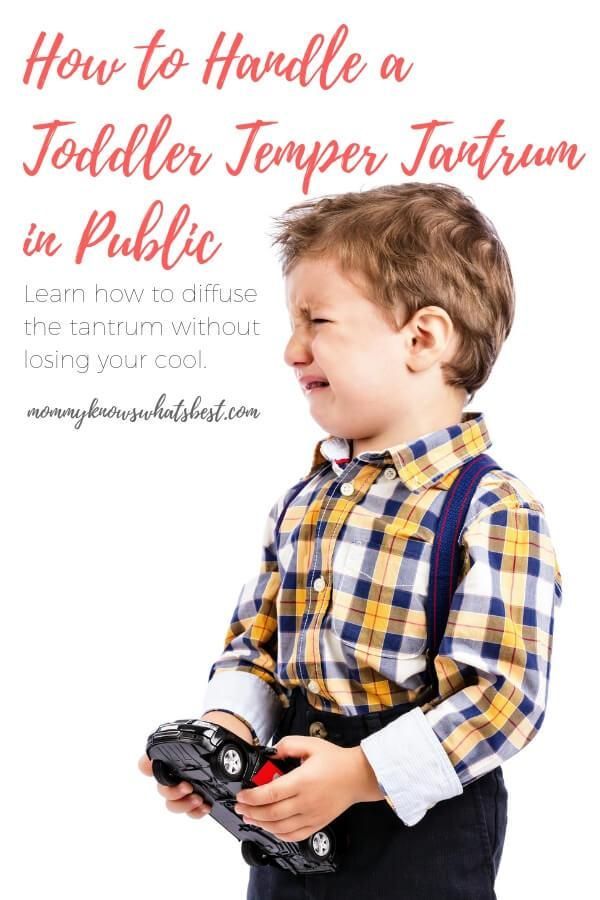
Another key strategy is to get to know your child’s signs of distress - Does he put his hands over his ears? Bolt from the room? Say “Go now!” or “Leave!”, or do you notice an increase in his self-stimulatory behaviors (rocking, humming, hand flapping, self-injurious behavior)?
These signs of distress can be indicators that your child is quickly becoming overstimulated and needs your help regulating before reaching the point of meltdown.
Next, let’s look at some strategies that may be helpful if your child is already experiencing an autism meltdown. The first strategy is to seek out a quiet, safe space. This may mean leaving the place that is causing the overstimulation (mall, grocery store, etc). Leaving the place of overstimulation will automatically decrease the stimuli that was over-stimulating your child, which means additional calming tools will likely be more effective.
Allowing your child a safe space to calm down will also mean changing the amount of sensory input they are exposed to. Keep yourself calm, help them become grounded by using appropriate eye contact, limit the verbal language you use, and offer deep touch pressure input to help your child calm down.
Keep yourself calm, help them become grounded by using appropriate eye contact, limit the verbal language you use, and offer deep touch pressure input to help your child calm down.
Check out our video on the 5 Steps to Build a Sensory Corner
Read more about Deep Touch Pressure here blog
In some instances, children on the autism spectrum experience extreme meltdowns due to high levels of over-stimulation. In these instances, your child might even engage in aggressive behaviors, such as screaming, kicking, or biting. Anger can be an outcome of over-stimulation, though the child’s intent is usually not to harm others, it is just that their level of tolerance has hit capacity. This can be very stressful for you as a parent, especially if occurring in a public place. In these instances, the most helpful thing to do is to find immediate ways to de-escalate the situation.
In these instances, the most helpful thing to do is to find immediate ways to de-escalate the situation.
Give your child the space they need, while also ensuring their safety and the safety of others around them. If you are able to safely move them away from the area of over-stimulation, this also can be helpful.
Removing the audience when possible is also helpful, as the presence of others may only make the situation worse. In most instances, allowing space will help de-escalate the situation on its own. When your child is starting to calm, it is best to get on their level physically, limit your verbal interactions, and offer any on-the-go calming tools you might have available. For example, a fidget tool or small, weighted item or lap pad.
It is important to note that the classroom can often be a place of over-stimulation for children with autism, due to the number of stimuli occurring and the presence of other people. If a child becomes aggressive in the classroom setting, the strategies mentioned above can be implemented.
As always, it is important to ensure the safety of the child and others above all else. Strategies such as turning off or dimming the lights and removing the audience might be especially helpful in a classroom setting.
If you’re on the go, you’ll want to consider ways to reduce the distractions in your environment and support your child’s ability to regulate with portable strategies. If you’re lucky enough to have an identified “cozy corner” or sensory deprivation area in your home, then great!
Portable Sensory Tool Kit for Meltdowns:Here are our top must-haves for a portable sensory tool kit to help with meltdowns on-the-go:
1) SunglassesSunglasses can be great for light sensitivity. Whether the sun can be too bright or your child has to deal with the harsh light of fluorescent light bulbs.
2) A Weighted Lap PadLike we mentioned above, deep touch pressure is a way to calm your child.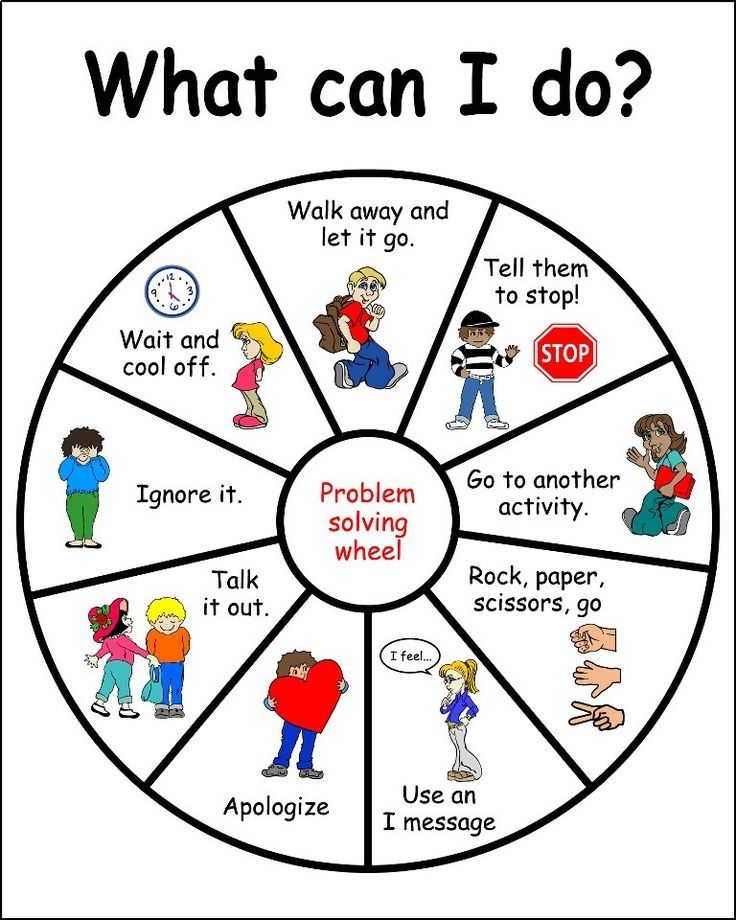 A weighted lap pad can help with this! If you get one like we offer at Harkla, the soft minky fabric can work as a fidget toy as well. And check out our weighted lap animal. It's an adorable option to help provide relief when your child feels stressed.
A weighted lap pad can help with this! If you get one like we offer at Harkla, the soft minky fabric can work as a fidget toy as well. And check out our weighted lap animal. It's an adorable option to help provide relief when your child feels stressed.
Often times, noises can become too much. Having a good pair of over the ear noise-canceling headphones to block out auditory stimuli or distraction can really help.
4) A Wide-brimmed hat or capThese can be helpful in allowing your child some distance from social interactions and also good for blocking any remaining light.
5) Chewy, Crunchy SnackWhile snacks are always good to have on hand, crunchy ones can help because oral proprioceptive input is calming and hungry kids are crankier!
6) Unscented hand wipesThese help with any tactile sensitivities when your child accidentally touches something that irritates them.
7) Preferred scented hand lotionThese can be helpful in combating offensive odors in the environment and instead offer a calming, preferred smell.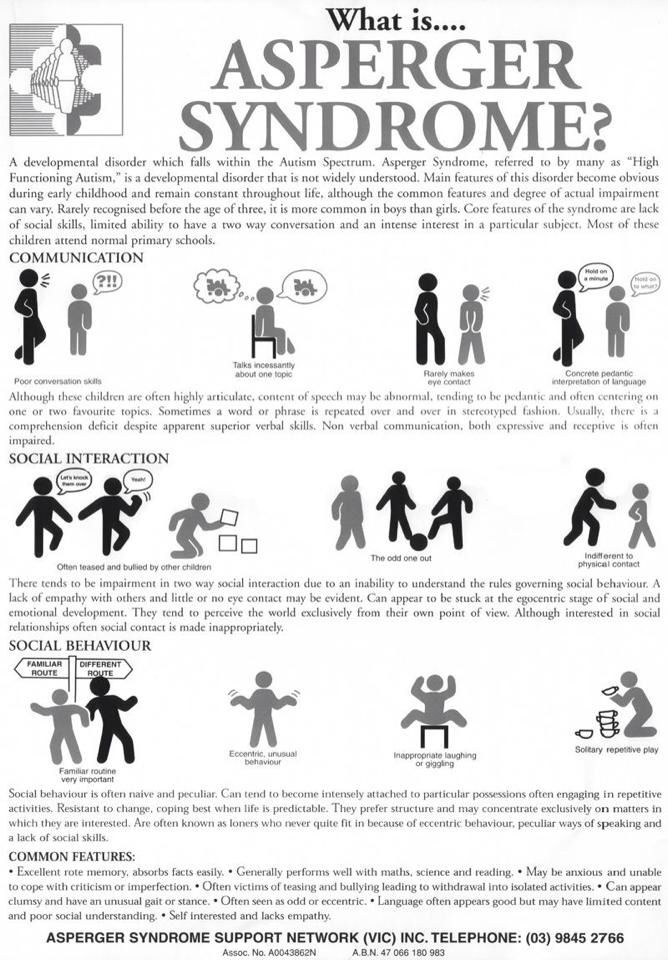
Something repetitive, simple, and preferred can have a calming effect. Check out our list of the best fidget toys to get.
As highlighted before, each child’s sensory needs will be different and the tools that are helpful for one child might not be helpful for another. The strategies above can be used across age groups, from toddlers to adults, depending on the individual’s unique needs. An occupational therapist can work with each individual to help assess and determine which sensory tools may be the most beneficial to aid in regulation.
Both tantrums and meltdowns are manifestations of difficulty with emotional regulation skills and if they persist beyond the stages of typical development, can be associated with other diagnoses like ADHD, autism, sensory processing dysfunction, learning disabilities, depression, and anxiety.
While tantrums are behavioral in nature, meltdowns have a sensory, physiological basis that warrants different management strategies. While neither are fun outbursts to experience, focus part of your energy on proactively supporting your child’s emotional regulation.
While neither are fun outbursts to experience, focus part of your energy on proactively supporting your child’s emotional regulation.
In the moments of tantrum or meltdown, use the guidelines we’ve outlined above to find what works for your child, and please share with Harkla what management strategies work for you!
Check out our video on Sensory Overload & Our 5 Favorite Strategies
Resources
"Autistic Meltdown or Temper Tantrum? by Judy Endow, MSW." Ollibean. N.p., 10 Nov. 2016. Web. 25 May 2017.
"26 Sensory Integration Tools for Meltdown Management - Friendship Circle - Special Needs Blog." Friendship Circle -- Special Needs Blog. N.p., 18 Nov. 2015. Web. 25 May 2017.
Bennett, David D. "Decreasing Tantrum/meltdown Behaviors of School Children with High Functioning Autism through Parent Training. " Social Science. N.p., 04 Feb. 2014. Web. 25 May 2017.
" Social Science. N.p., 04 Feb. 2014. Web. 25 May 2017.
Caroline Miller. "Why Do Kids Have Tantrums and Meltdowns?" Child Mind Institute. N.p., n.d. Web. 25 May 2017.
Morin, Amanda. "The Difference Between Tantrums and Sensory Meltdowns."Understood.org. N.p., n.d. Web. 25 May 2017.
"Why Toddlers Throw Temper Tantrums." Parenting. N.p., 17 Feb. 2015. Web. 25 May 2017.
How to deal with tantrums of a child with autism in public places?
05.02.14
Recommendations of a children's psychologist for prevention and response to behavioral crises of autistic children
Author: Lauren Elder
Source: Autism Speaks
9000 9000 9000 9000 for all. However, it is especially difficult to deal with it if it has been stepped on in a public or crowded place. Here are some tips for parents whose kids are prone to tantrums in public. nine0003
Children with autism especially benefit from visual cues and social stories to help them better understand your expectations. You can write a separate social story for each visit to a public place that you and your child will have. For example, it could be a story about how a child goes to the grocery store with his mother, and how he does not like that it is too noisy there. He wants to scream, but instead he asks his mother for help. She gives him a big hug to help him calm down and tells him that they will leave the store in 5 minutes and also offers him some earmuffs. nine0003
You can write a separate social story for each visit to a public place that you and your child will have. For example, it could be a story about how a child goes to the grocery store with his mother, and how he does not like that it is too noisy there. He wants to scream, but instead he asks his mother for help. She gives him a big hug to help him calm down and tells him that they will leave the store in 5 minutes and also offers him some earmuffs. nine0003
You can use pictures to tell your child a story or otherwise communicate your expectations of their behavior. For example, you can make a special card that your child can give you when he feels too stressed and needs a break.
When visiting a public place, you can use a series of pictures to support you, illustrating the upcoming event step by step. This will help the child to understand in advance what awaits him. You can use a now-then board with two pictures illustrating what will happen now and what will happen next.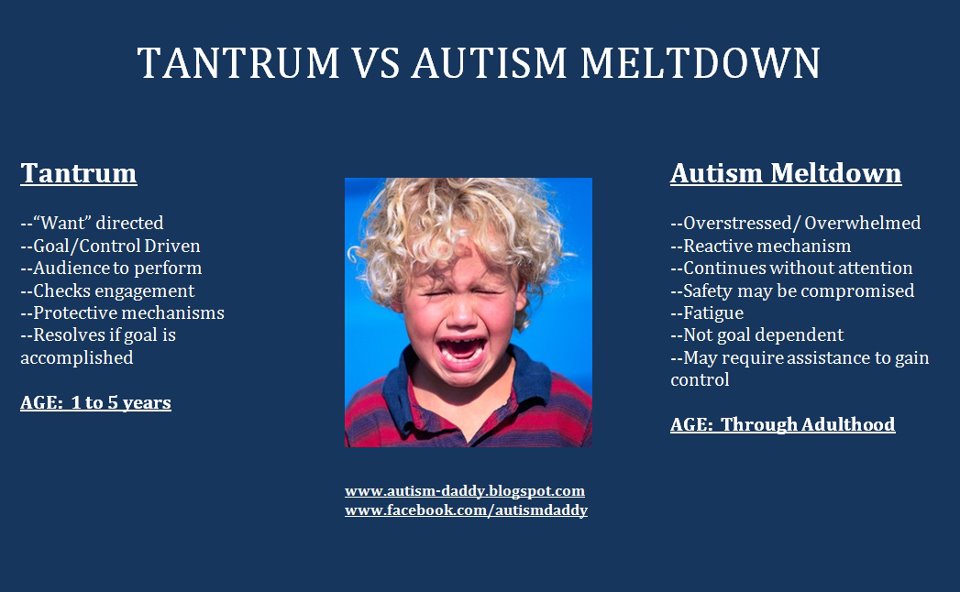 For example, in the first picture the child is sitting quietly in a restaurant, and in the second picture there is a reward that you promised him for good behavior. nine0003
For example, in the first picture the child is sitting quietly in a restaurant, and in the second picture there is a reward that you promised him for good behavior. nine0003
Preliminary practice. Role-play a trip to the store, library, restaurant, or any other place you plan to take your child. Help your child practice good behavior during role play. Lose and the occurrence of potential problems. These problem rehearsals can help your child get through a long line or come to terms with their favorite toy not in the store.
Start small. It is best to start small, return home as soon as possible, or return to this place after a long break. So if you are planning your first visit to a restaurant, then order only an appetizer, dessert or drink, and then leave. When returning to the grocery store after a long break, grab just one item and head straight home. Gradually increase the time the child spends in public places, determining his readiness by his behavior.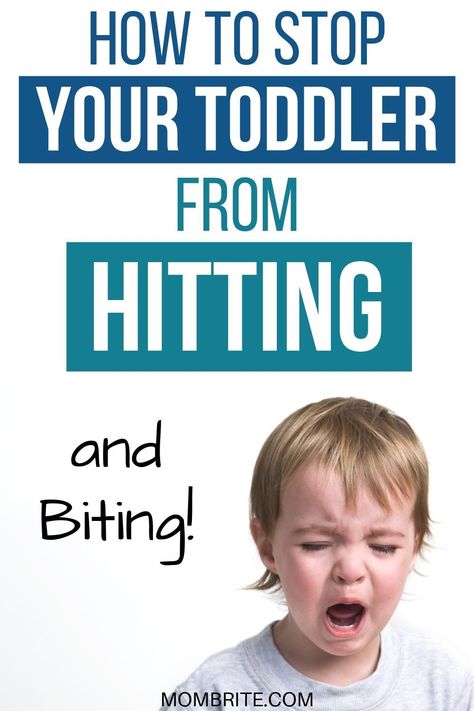 Remember, one success leads to another. nine0003
Remember, one success leads to another. nine0003
Get your child involved. Help your child be as active and responsible as possible when visiting public places. For example, instruct him to put all the goods in a cart in a supermarket. Or let him choose a book from the library himself.
Have toys or other items ready to distract your child. It is easier for any child to endure the inevitable with the help of a small favorite toy or computer game.
Teach your child self-soothing strategies. It's helpful to come up with several possible things that can soothe your child. You yourself know best what could help him. One such strategy is to prompt the child to take deep breaths. Another strategy is to ask him to close his eyes and count to 10 or think of his favorite place. Other children may pick up their favorite soft toy or hum their favorite song under their breath. It is important to identify all possible self-soothing strategies and practice them in a comfortable environment where the child is calm. Only then will it be easy for the child to resort to these strategies in a state of stress. nine0003
Only then will it be easy for the child to resort to these strategies in a state of stress. nine0003
Reward good behavior. In addition to explicit expectations, describe what rewards will follow for good behavior. For example, explain to your child that if he does not grab everything and scream in the store, then when he returns home, he will have 15 minutes of his favorite game waiting for him. The expectation of a positive event can motivate him to good behavior.
Preparation and planning can greatly reduce the risk of a tantrum in a public place. However, most likely, they will not reduce them to zero. Here are some tips for responding to a behavioral crisis in a public place:
Remain calm. Take deep breaths and try to assess the situation.
Stop and help the child. If possible, stop what you are doing and focus on helping your child. First of all, remind him of the rehearsed strategies for self-soothing and/or try to distract him with a toy or object that you have taken for this purpose.
Tell the witnesses of the tantrum what they should do. If necessary, you can say something like: “My son has autism. Please step back. Free space will help him calm down. Some parents whose children are prone to tantrums carry special business cards or flyers that explain what autism is and what their child's behavior is related to. This allows you to not go into explanations in front of the child, but simply hand out a business card or flyer if necessary. Most people will be willing to help if they have information about what exactly is going on. Don't be afraid to ask a stranger to call the store manager for help or to help move dangerous items away from the child. In the most extreme situations, it may be necessary to call an emergency service, although this option is not liked by anyone. In any case, the safety of the child and others must come first. nine0003
Raising children with autism
Tantrums in autism: what is the cause and what to do?
23. 06.20
06.20
Guide to parents on how to distinguish simple “scandals” from a nervous breakdown during autism, and what can be done in each case
Source: Autism Parenting Magazine
All parents have experienced embarrassment, irritation and fatigue when their child throws a "tantrum". It doesn't matter if a child has a diagnosis or what stage of development he is at, both experienced parents and newcomers are faced with violent emotional outbursts in a child. It's inevitable - if you have a child, you'll deal with behavioral outbursts one way or another. nine0003
If your child is on the autism spectrum, then you have an additional unique parenting skill - the ability to cope with nervous breakdowns. You cannot always predict what will cause a violent scandal or emotional outburst on any given day or in any given environment. To do this, you will have to be superparents with an infinite set of tools and limitless flexibility and sixth sense.
Neither behavioral scandals nor nervous breakdowns look attractive, but in many families of children with autism they happen very often and can be a source of serious stress. It is very important to understand the difference between these two phenomena. Although both may look like a "hysteria," a scandal and a nervous breakdown are not the same thing, and they require completely different approaches. nine0003
What is a "scandal"?
Scandal or behavioral outburst usually occurs when a child is denied what he wants or cannot do what he wants to do.
Parents often face constant scandals at the age of 2-3 years of the child, or during the so-called "crisis of three years", when young children begin to assert their independence. In fact, the “crisis of three years” is a developmental stage that usually takes place between the ages of 1 and 4 years, because the child needs time to develop the necessary motor, speech and thinking skills. nine0003
Preschool children are often prone to "scandals" because they lack the skills needed to cope with difficult situations on their own. Why is this happening? There are several reasons for this:
Why is this happening? There are several reasons for this:
- They have a desire to be independent, but they lack the motor and cognitive skills (the ability to plan, coordinate and execute actions) to actually BECOME independent.
- In addition, their speech skills are just beginning to develop, so it is difficult for a child to express what he wants and what he needs, and such difficulties can drive him crazy. nine0003
- The child's prefrontal cortex is still underdeveloped. This is the part of the brain that is responsible for emotional regulation and social behavior. The child literally has no ability to regulate his behavior!
- As the child begins to understand the world around him more and more, this very world can cause him anxiety. Such anxiety, coupled with insufficient control over the environment, often leads to behavioral outbursts - it is simply difficult for a child to cope with everything that is happening around. nine0003
A key feature of such scandals is that this behavior persists and intensifies if you somehow pay attention to the child during the explosion.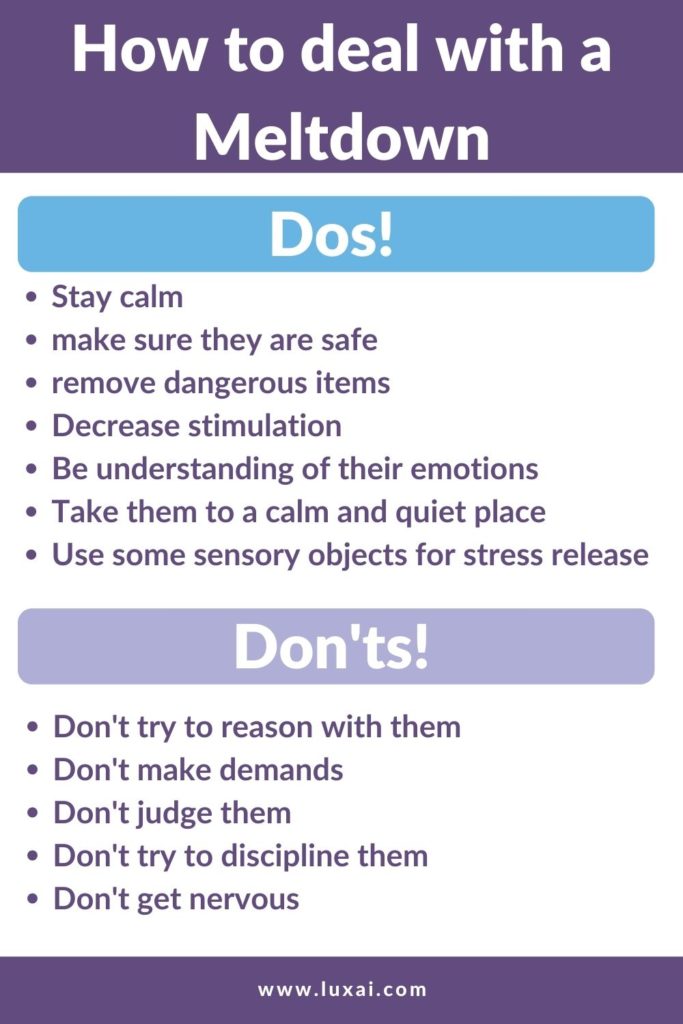 If you start consistently ignoring the child when he "scandals", the outbursts will subside.
If you start consistently ignoring the child when he "scandals", the outbursts will subside.
When a child "scandals", he retains the ability to control his behavior, this behavior may increase or decrease depending on the behavior of adults around him. The scandal stops when the child gets what he wants, or when he realizes that the outbreak will not lead to the desired result. nine0003
If parents 'give in' during outbreaks from time to time, children will start arguing again and again, since this behavior has proven effective if they are denied what they want.
As children mature, they develop self-regulation skills to deal with anxiety and anger. If the "tantrum"-like behavioral outbursts are not appropriate for the child's developmental stage, it can lead to great social and emotional difficulties due to inappropriate behavior. nine0003
What is a "nervous breakdown"?
A nervous breakdown occurs when a child loses control of his behavior and can only calm down when he reaches the stage of exhaustion.
A nervous breakdown is a reaction to overload, for example, very often the result of excessive sensory stimulation. Scandals can lead to nervous breakdowns, so it's often difficult to distinguish between these two behavioral outbursts if you don't understand the child's sensory responses well.
When a person with autism experiences too much stimulation from the environment, it can lead to an overload of the central nervous system, which loses the ability to process incoming information. This is actually a physiological "traffic jam" in the central nervous system, and behavior in response to sensory overload is the problematic behavior of a driver who is stuck in traffic. Imagine that you are calmly driving to your destination, humming your favorite song, and then suddenly the highway is completely up. Now you can’t continue on your way, your expectations of the situation have not been met at all, you are surrounded by huge trucks, you are inhaling exhaust fumes, you are deafened by car horns, and your car windows are in direct sunlight. Anxiety about the situation itself is heightened by all these sensations, and you start sensory overload. The last thing you want is to stay in this traffic jam, but you have no way out. Irritation and overexertion are normal reactions in such a situation. Maybe you turn off the radio, close your eyes, try to take deep breaths to calm down (a socially acceptable desirable behavior). OR you jump out of the car and yell in a fit of rage (unwanted maladaptive behavior). nine0003
Anxiety about the situation itself is heightened by all these sensations, and you start sensory overload. The last thing you want is to stay in this traffic jam, but you have no way out. Irritation and overexertion are normal reactions in such a situation. Maybe you turn off the radio, close your eyes, try to take deep breaths to calm down (a socially acceptable desirable behavior). OR you jump out of the car and yell in a fit of rage (unwanted maladaptive behavior). nine0003
During times of increased anxiety and stress, the sympathetic part of our autonomic nervous system starts producing the hormone cortisol and triggers the fight or flight response. When people with autism or sensory processing dysfunction experience sensory overload, they are unable to regulate sensory signals from the environment, and their bodies begin to perceive these signals as a huge threat.
In moments of a nervous breakdown, control over behavioral reactions is lost. And it is very important to remember this - you cannot expect logical and rational answers in a situation where the child's body perceives ordinary sensory signals as an attack. nine0003
nine0003
Because of this difference in control over one's behavior, strategies for a scandal and a nervous breakdown must be very different.
How can scandals be dealt with?
Strategies for dealing with scandals come down to positive behavioral support and the development of alternative behaviors. There are now many books and articles adapted for parents on how to deal with unwanted child behavior. Most of these approaches boil down to three main strategies:
1. Definition of motivation, that is, the purpose of behavior.
It is important to understand that when a child "scandals" this behavior has a specific purpose. Typically, a behavioral scandal serves a child in one of the following ways: to get the attention of other people (for example, parents), to get some objects or activities (that the child wants, but was denied or access to them is delayed), or to avoid something. - something he doesn't like.
Once you understand WHY the child is fighting, you will be able to understand how you can react to it.
2. Encouragement of positive behaviour.
Start "catching" the child when he behaves well. For example, when he does NOT make a fuss in response to small problems, praise him and reward him for good behavior. Depending on what your child prefers, it could be a hug, a high-five, or a good job. This is how you teach your child that he can get your attention not only through "bad" behavior, but also through "good" behavior. Focusing on what the child did right will help the child build on those successes and behave more positively in the future! nine0003
3. Develop skills for success.
We know that a child's frequent fights can indicate a lack of patience, a lack of a way to communicate one's desires, a lack of knowledge of what behavior is expected in a given situation, an inability to comfort oneself. It is important to look for opportunities to develop these skills in your child and help them be successful.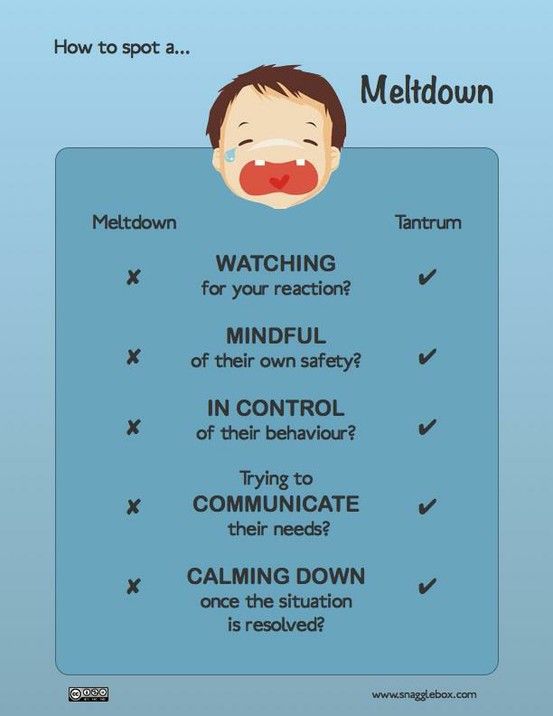 However, it is important to work on these skills every day and NOT when the child is fighting.
However, it is important to work on these skills every day and NOT when the child is fighting.
Strategies for Breakdowns in Children with Autism
You've probably heard the expression, "If you know one person with autism, you know one person with autism." Each child with autism responds differently to different situations, has different skill levels, and different sensory, communication and social profiles, so there is no single strategy that will help with any child's breakdown. Below are a few tips and strategies that have helped other parents, but you need to consider how they fit the individual child:
1. Visual schedules for the day, social stories, to-do lists, schedules for a specific event or task
We all would like to completely avoid nervous breakdowns, but this is impossible. Instead, strategies that reduce stress and anxiety in everyday life, and therefore reduce the risk of a nervous breakdown, can be very helpful. Visual timetables, social stories, checklists, and other visual support help your child become aware of what is expected of him and what is expected of him. For example, if you are planning a trip to the store, then search the Internet for photos of this particular store, place them in the child’s visual schedule for the day. Or, if you have the opportunity, go to the store without your child and film your trip to the store, then watch the video with your child at home. Or write a social story with illustrations about going to the store, what it is for, and what will happen from the beginning to the end of such an event, and read the story with your child. Such strategies create predictability and a sense of control for the child, which reduces anxiety. Over time, also teach your child “surprises” in the schedule so that he can cope with unexpected events in the usual daily routine. nine0003
For example, if you are planning a trip to the store, then search the Internet for photos of this particular store, place them in the child’s visual schedule for the day. Or, if you have the opportunity, go to the store without your child and film your trip to the store, then watch the video with your child at home. Or write a social story with illustrations about going to the store, what it is for, and what will happen from the beginning to the end of such an event, and read the story with your child. Such strategies create predictability and a sense of control for the child, which reduces anxiety. Over time, also teach your child “surprises” in the schedule so that he can cope with unexpected events in the usual daily routine. nine0003
2. Regular "sensory unloading" in the child's schedule.
Regular sensory unloading, the so-called "sensory diet", is an important component that helps the child to regulate his condition during the day. Some parents have found it helpful to prevent breakdowns by scheduling regular “quiet times” for their children, rather than waiting for the events of the day to overwhelm them.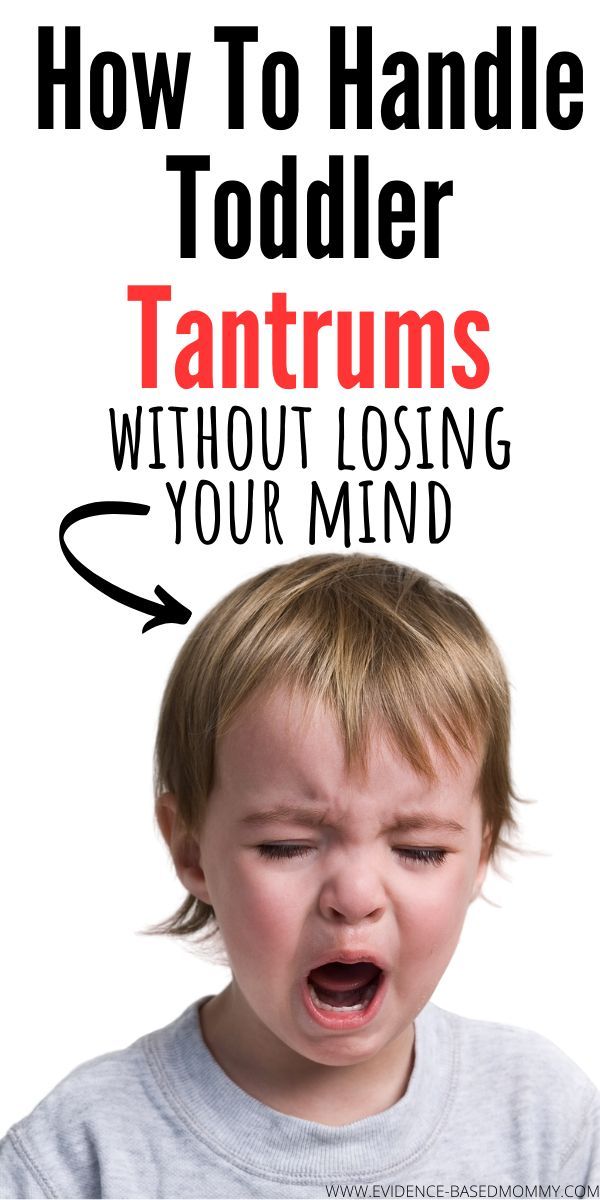 This is important to take into account, especially if you are planning visits to new and noisy places for the child. Since a nervous breakdown is the result of many different environmental stimuli whose effect "accumulates", it is best to schedule some quiet time with relaxing sensory activities before going out in public with your child. nine0003
This is important to take into account, especially if you are planning visits to new and noisy places for the child. Since a nervous breakdown is the result of many different environmental stimuli whose effect "accumulates", it is best to schedule some quiet time with relaxing sensory activities before going out in public with your child. nine0003
3. Knowing the signs of severe stress in a child.
Another important strategy is to be aware of the first signs that a child is under severe stress. Does the child press his hands to his ears? Runs out of the room? Repeats "Go away!" or "Let's go home!", or do you notice a sharp increase in repetitive behavior (for example, the child sways, hums under his breath, shakes his hands)? These signs of extreme stress may indicate that the child is being over stimulated and needs your help to regulate before they develop into a full-blown breakdown. nine0003
If the child is unable to speak, or their language skills become unreliable or lost during a nervous breakdown, they will need some form of non-technological alternative communication, such as a “choice board” where the child points to one of the images from a few to explain what he wants.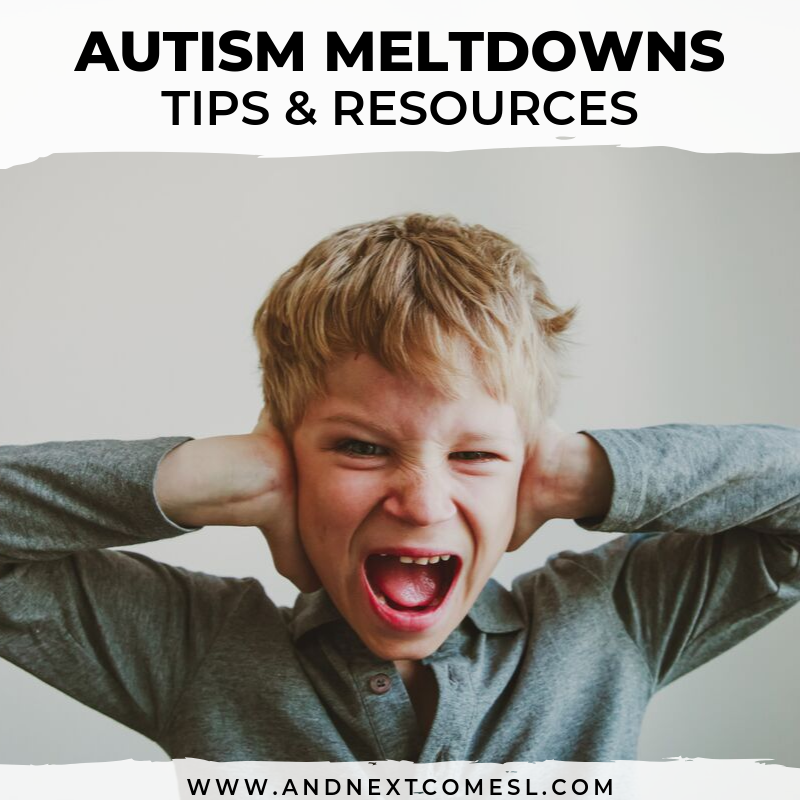 The child may use alternative communication to let you know when he needs to leave the situation or use a different strategy to bounce back. nine0003
The child may use alternative communication to let you know when he needs to leave the situation or use a different strategy to bounce back. nine0003
Some children need a predetermined sign that both of you understand (hand gesture, signal word) to communicate sensory overload and thus ask for help.
4. Finding a quiet and safe space.
If you have a nervous breakdown, it is important to find a quiet and safe place. This may mean that you need to leave a place that causes overstimulation (for example, a store). The safe space may also include techniques that reduce sensory information. Remain calm, keep speech to a minimum and, if possible, be silent, offer the child deep pressure, such as hugs, to calm down. If the child is likely to run away or his behavior could become dangerous to himself or others, he may need to be restrained for safety. nine0003
Outsiders in public places may not understand the situation and their behavior may exacerbate the crisis. It is helpful to make special cards in case of a nervous breakdown - these are cards made by parents that explain the diagnosis of the child and the reasons for his cries, why he is held, or other behavior that may alert other people. When you're focusing on a child's breakdown, a ready-made card that can be held out silently can save you from unnecessary explanations or false accusations of abuse. nine0003
It is helpful to make special cards in case of a nervous breakdown - these are cards made by parents that explain the diagnosis of the child and the reasons for his cries, why he is held, or other behavior that may alert other people. When you're focusing on a child's breakdown, a ready-made card that can be held out silently can save you from unnecessary explanations or false accusations of abuse. nine0003
5. Remember to breathe.
This is not so much a strategy for the child as it is for you. Breathe, try not to take what is happening with the child at your own expense. As difficult as it may be, try to notice your emotional reactions (anger, embarrassment, sadness). Remind yourself that your child has lost the ability to control his reactions at the moment. By staying calm and in control of yourself, you are already doing a lot to help your child get through this difficult moment. nine0003
6. Portable sensory set for the prevention of nervous breakdowns.
Here are some examples of what parents carry outside the home to prevent a nervous breakdown or to help their child calm down after one.
- Sunglasses (if you are sensitive to bright light).
- Earmuffs (to reduce noise or to distract the child with music).
- Wide-brimmed hat or cap (as a way to distance yourself from social interaction and block out the light from above). nine0003
- Snack that can be crunched or chewed for a long time (stimulation of the muscles in the mouth can have a calming effect, and hungry children become more irritable).
- Unscented wet wipes (to help with tactile sensitivity if the child accidentally touches something that irritates him).
- Hand lotion with a favorite scent (may help reduce environmental odors as well as provide a soothing effect). nine0003
- A "sensory" toy is a toy that can be used to make repetitive, simple movements that can have a calming effect.
- Communication board with pictures or printed words, eg "I need a break", "Let's go", "Too loud".
- Explanation cards or other way to let strangers know what's going on and why you're reacting the way you do.
The main thing to remember is that nervous breakdowns due to overload are important to distinguish from scandals when a child tries to get his way, since they require different approaches. Both phenomena are extremely unpleasant for all involved, so it is important to put as much effort as possible into actively teaching the child how he can regulate his emotional state. Try to find strategies that work best for your child. Just remember to breathe and stay calm. nine0003
See also:
Autistic Meltdown or Temper Tantrum? by Judy Endow, MSW.” Ollibean. N.p., 10 Nov. 2016. Web. 25 May 2017.
“26 Sensory Integration Tools for Meltdown Management – Friendship Circle – Special Needs Blog.” Friendship Circle - Special Needs Blog. N.p., 18 Nov. 2015. Web. 25 May 2017.
Bennett, David D. “Decreasing Tantrum/Meltdown Behaviors of School Children with High Functioning Autism through Parent Training.

